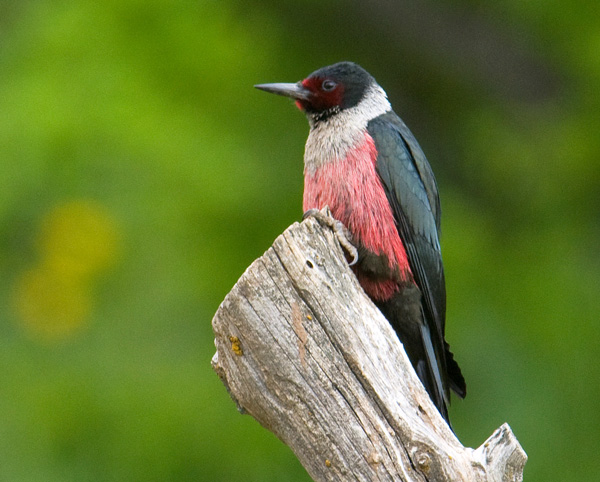|
Utah Bird Profile |
||||||||
|
Name Roots: (Gr. melas, "black"; herpes, "a creeper" - for Meriwether Lewis) |
||||||||
| In Utah: |
 by Richard Pontius |
|||||||
| Nesting, feeding, characteristic behaviors: |
Unlike most woodpeckers, it flies steadily and straight like a crow, and can
often be observed flycatching from exposed branches. ~Merrill Webb Nests in a deciduous tree or in a snag at a height of 5-100 (To 170) feet, in a cavity nest. This species is not a cowbird host. During the breeding season, this species is an insectivore: air sallier;. During the non-breeding seasons this species is a granivore: upper-canopy gleaner. |
|||||||
| Habitat: | Open woodlands and riparian forests
where there are many dead trees Breeds in Utah in ponderosa pine and lowland riparian habitats. |
|||||||
| How to find: |
Usual Places: Utah County
This species, which I think is one of the most beautiful birds in Utah, is
listed as an uncommon permanent resident on the state checklist. Unlike most
woodpeckers, it flies steadily and straight like a crow, and can often be
observed flycatching from exposed branches. It is usually associated with
open woodlands and riparian forests where there are many dead trees.
However, in Utah County this woodpecker is usually found where there is
abundant, mature Gambel’s Oak that supplies them with acorns. One of the
most reliable places to observe this species in Utah County is east of the
town of Salem and north of Woodland Hills where there is a band of Gambel’s
Oak that lines the south part of the valley. Be sure to check out the
telephone poles in this area, and also in the area of the Salem Cemetery
because they seem to like “perching” on these exposed poles. Two other
consistent localities has been Harker Canyon in the Sheeprock Mountains
southwest of the small town of Vernon in Tooele County and Milburn, a small
farming community, just north of Fairview in Sanpete County. In eastern Utah
one of the most dependable localities has been Ouray National Wildlife
Refuge. When visiting these sites be sure to check the large, dead, or
dying, cottonwood trees. ~Merrill Webb |
|||||||
|
|
USGS Profile
(Geological Survey) |
US
Winter Range Map |
US
Summer Range Map | |
||||||||
|
||||||||
|
Abbreviations | References | Legend
|
||||||||